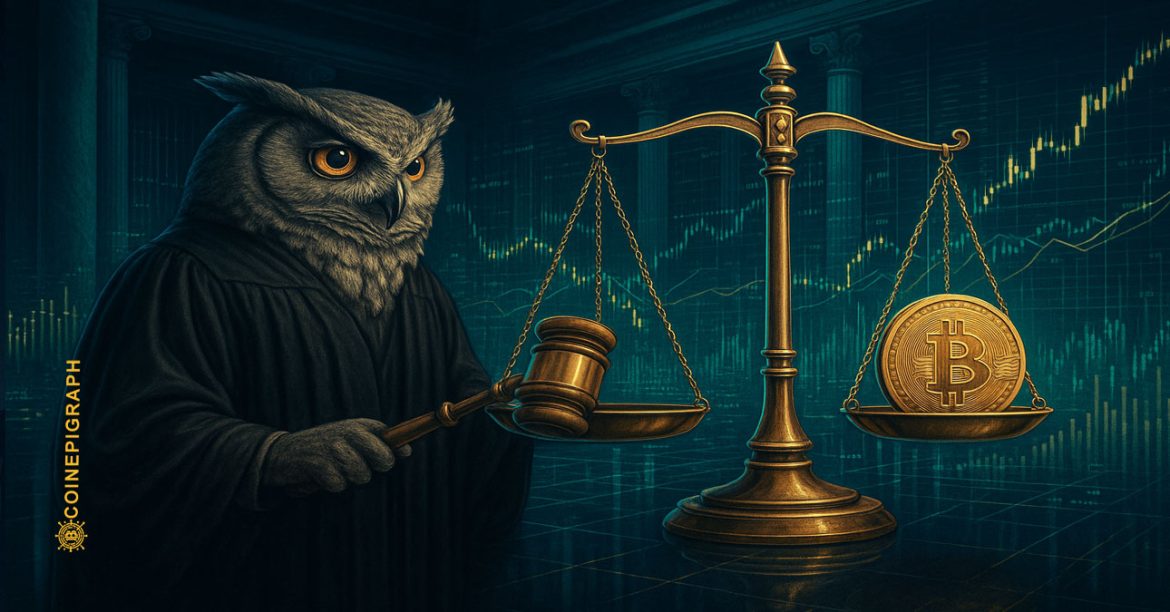By CoinEpigraph Editorial Desk | November 9. 2025
The Case Before the Court
The United States Supreme Court is now weighing one of the most consequential economic questions of the decade: does the president have the unilateral right to impose tariffs under the International Emergency Economic Powers Act (IEEPA)?
At stake is more than the legality of a past policy. It’s about who controls the economic throttle — Congress or the Executive — and how that balance shapes global capital flows. Lower courts have already signaled discomfort, calling the Trump-era tariffs an “overreach” of emergency powers. Now, with arguments set for November 2025 and a decision expected early next year, markets are bracing for impact.
This is not a symbolic fight. The ruling could redefine how U.S. trade, inflation, and even digital asset valuations behave in a global economy still recovering from pandemic-era and protectionist aftershocks.
The Bullish Case: Markets Love Predictability
In the bullish view, any decision that reins in unilateral executive power is inherently stabilizing. Investors crave rules over improvisation.
A favorable ruling — one that limits tariff authority — could signal a return to orderly, rule-based policy. That means fewer overnight trade shocks and a more transparent outlook for multinational supply chains. As one strategist put it, “Markets have been operating with one eye on the White House for years. A return to congressional oversight restores a sense of order.”
1. Stability as a Catalyst
When policy becomes predictable, capital redeploys. Equity markets could interpret a limitation on executive tariffs as a green light for long-term planning — easing inflation expectations, lowering import volatility, and lifting industrial valuations.
2. Crypto’s Indirect Boost
In digital markets, predictability equals confidence. The crypto sector — often a high-beta reflection of risk sentiment — tends to rally when macro turbulence subsides. Bitcoin’s drawdowns during tariff escalations in 2019 and 2020 underscore that linkage. A restrained executive branch could be read as “macro relief,” encouraging speculative rotation back into digital assets.
3. Rule-of-Law Optics
Globally, the optics matter. A Supreme Court decision reaffirming checks and balances would strengthen the perception of institutional maturity — a factor that underpins the U.S. dollar’s reserve role. Ironically, the same logic often benefits crypto, which thrives when rule-of-law and transparency bolster investor confidence across asset classes.
The Bearish Case: Policy Gridlock and Fiscal Fallout
The opposing camp warns that the same decision could unleash short-term confusion and fiscal uncertainty. If the Court strikes down key tariff powers, the Treasury may owe massive refunds — possibly “about half” of collected duties, according to a Politico estimate. That’s not stability; that’s shock.
1. Refund and Repricing Risks
Billions in retroactive refunds could jolt federal revenue assumptions, introducing fiscal stress at an awkward time. Supply chains might freeze while Congress scrambles to legislate new trade authorities. Markets, allergic to ambiguity, could recoil.
2. A Dollar Paradox
If the decision is seen as proof of U.S. institutional strength, investors might flock into Treasuries, pushing the dollar higher. Crypto — which often moves inversely to the dollar — could see temporary pressure even as equities recover.
3. The Gridlock Factor
A restrained presidency also means slower policy responses. Should new trade conflicts arise, an executive stripped of emergency tariff levers may need congressional consensus — a rare commodity in modern politics. “Markets prefer one decision-maker to ten committees,” warned a former trade attorney. “If tariff power fragments, expect a few months of fog.”
The Constitutional Frame: Checks, Balances, and Capital
Beneath the financial debate lies a constitutional pulse. Congress, not the President, holds the power to regulate foreign commerce. Yet decades of statutory flexibility — from the 1974 Trade Act to IEEPA — have blurred that boundary.
If the Supreme Court reasserts the non-delegation principle or leans on the Major Questions Doctrine, it will do more than decide a trade case. It will signal that the era of “open-ended economic emergency” might be closing. For investors, that’s a new map of risk itself.
Crypto’s Split Screen
Crypto analysts are split.
The bullish camp sees institutional restraint as bullish structure: fewer geopolitical shocks, smoother capital inflows, and a friendlier environment for tokenized assets. To them, Bitcoin’s role as “digital gold” becomes more credible when fiat governance is predictable.
The skeptical camp counters that crypto feeds on volatility — that its speculative magnetism thrives when traditional systems falter. If the Court stabilizes the macro landscape, the next euphoric inflow might go to equities, not Ethereum.
The crypto press is already divided. The Block hailed a coming “judicial bull run.” Decrypt called it “a risk premium reset.” CoinDesk warned it could “strengthen the dollar and cap short-term crypto upside.” Each camp is watching a different chart — one through macro discipline, the other through narrative liquidity.
Outlook: Law Meets Liquidity
However the Court rules, markets will interpret it less as a legal decision than a signal of systemic direction.
If the executive’s tariff reach is curtailed, investors may price in renewed stability — a quiet tailwind across risk assets. If the Court upholds it, volatility returns to the front row, and traders may brace for the next unilateral shock from 1600 Pennsylvania Avenue.
Either way, one truth remains: the line between law and liquidity has never been thinner.
At Coinepigraph, we pride ourselves on delivering cryptocurrency news with the utmost journalistic integrity and professionalism. Our dedicated team is committed to providing accurate, insightful, and unbiased reporting to keep you informed in the ever-evolving crypto landscape. Stay tuned as we expand our coverage to include new sections and thought-provoking op-eds, ensuring Coinepigraph remains your trusted source for all things crypto. -Ian Mayzberg Editor-in-Chief
The team at CoinEpigraph.com is committed to independent analysis and a clear view of the evolving digital asset order.
To help sustain our work and editorial independence, we would appreciate your support of any amount of the tokens listed below. Support independent journalism:
BTC: 3NM7AAdxxaJ7jUhZ2nyfgcheWkrquvCzRm
SOL: HxeMhsyDvdv9dqEoBPpFtR46iVfbjrAicBDDjtEvJp7n
ETH: 0x3ab8bdce82439a73ca808a160ef94623275b5c0a
XRP: rLHzPsX6oXkzU2qL12kHCH8G8cnZv1rBJh TAG – 1068637374
SUI – 0xb21b61330caaa90dedc68b866c48abbf5c61b84644c45beea6a424b54f162d0c
and through our Support Page.
🔍 Disclaimer: CoinEpigraph is for entertainment and information, not investment advice. Markets are volatile — always conduct your own research.
COINEPIGRAPH does not offer investment advice. Always conduct thorough research before making any market decisions regarding cryptocurrency or other asset classes. Past performance is not a reliable indicator of future outcomes. All rights reserved ™ © 2024-2025.





